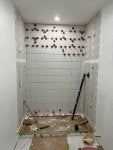I plan to finish my shower tile with a Schluter type L trim piece. I will be installing one continuous piece on either side of my shower from my finished tile floor to the ceiling. I plan to leave a 1/8 gap under the trim off of the floor as I assume it shouldn't be resting on it. I plan to overhang my tile 3" past the edge of the shower pan. I will be using a laser to keep everything straight.
What is the best strategy for newbie who will be tiling slow up the wall?
Do I set the trim piece on the wall before I tile? If so, what is the best way to do so?
Thanks.
What is the best strategy for newbie who will be tiling slow up the wall?
Do I set the trim piece on the wall before I tile? If so, what is the best way to do so?
Thanks.







